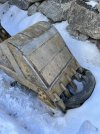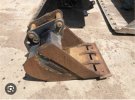Columbo
Senior Member
I have final grading and a septic to complete around my house project in the spring. I’ve been considering a smooth edge bucket for these tasks (Cat 311B excavator ). I do not have hydraulics to the end of the stick so it will be a fixed position “cleanup” bucket. After several months of looking I haven’t found many available options locally. So, I have a few questions:
First, would a smooth edge bucket make these job significantly easier?
Second, one of the buckets I often see for sale locally is an EMAQ or Teran brand. They look like imported buckets but the new list price is in my budget. Are Chinese buckets a bad idea for non-commercial use?
Finally, the bucket on my excavator is a standard Cat 36” bucket (including side cutters). Would welding a smooth edge to a few of the teeth to make a removable smooth be an economical solution or would I miss the size or geometry of a 60” cleanup bucket? Pics of my bucket and this idea below.


First, would a smooth edge bucket make these job significantly easier?
Second, one of the buckets I often see for sale locally is an EMAQ or Teran brand. They look like imported buckets but the new list price is in my budget. Are Chinese buckets a bad idea for non-commercial use?
Finally, the bucket on my excavator is a standard Cat 36” bucket (including side cutters). Would welding a smooth edge to a few of the teeth to make a removable smooth be an economical solution or would I miss the size or geometry of a 60” cleanup bucket? Pics of my bucket and this idea below.


